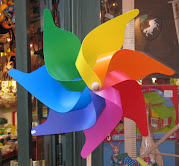 Yesterday after walking in the mid day sun in Tiergarten some of us went to the New National Gallery which is in part of former west Berlin that was in no-man's land. The Berlin Philharmonie and Herbert von Karajanstrasse are part of the same space. The whole area around Potsdamerplatz was destroyed at the end of the war, then with building of the wall there was not much reason for business to move there so major cultural buildings were put up in the space. The 19th cnetury church stands in the middle of all of these museums and concert halls, there are no flats or houses in site, yet from the outside at least the church seems to offer some kind of ministry to the world of the performing and decorative arts.
Yesterday after walking in the mid day sun in Tiergarten some of us went to the New National Gallery which is in part of former west Berlin that was in no-man's land. The Berlin Philharmonie and Herbert von Karajanstrasse are part of the same space. The whole area around Potsdamerplatz was destroyed at the end of the war, then with building of the wall there was not much reason for business to move there so major cultural buildings were put up in the space. The 19th cnetury church stands in the middle of all of these museums and concert halls, there are no flats or houses in site, yet from the outside at least the church seems to offer some kind of ministry to the world of the performing and decorative arts.
Meanwhile with the fall of the wall Potsdamerplatz became the place where the "triumph of capitalism" needed to become visible and just further down from the Philharmonie is an enormous shopping centre. It's quite a strange bit of city architecture - born of war and the divisions of history. I do wonder at the hubris of the new development - although of course I visited the shops too.
The permanent exhibition at the gallery tells the story of German history through the art and artists of the time - or maybe that should be it tells the story of German art through its history. At various points in the exhibition there are black and white reproductions of "lost" works - mostly art willfully burnt and destroyed befor the war. It's a powerful way of pointing to the holes in the collection - at first you don't quite notice that something is different.
The 20th century art in the gallery is challenging and powerful stuff, trying very often to tell a story with brash colours and satiricial themes - even if the horrors of the Third reich later went well beyond satire. The colours and lighting of the famous painting by George Grosz particularly struck me yesterday. Looking at the paintings I thought about how Christians and church leaders sometimes go on about the importance of the prophetic word, speaking the truth to power. Yet here were artists - often atheists or like Max Beckman questioning "God's mistakes" - who were painting, sculpting and drawing their perhaps much more prophetic view of society. One of the figures in Grosz' painting is a judge who could be mistaken for a cleric ...
uncomfortable and powerful viewing.
Meanwhile I was rather less convinced by Rudolf Stingel's carpet and chandelier installation in the upstairs area. Also black and white but it didn't quite tell a story for me but then I've never been very fond of patterned carpets.
Wednesday, 7 April 2010
What is lost is only there in black and white - wandering around the new national gallery in Berlin
Subscribe to:
Post Comments (Atom)






0 Comments:
Post a Comment